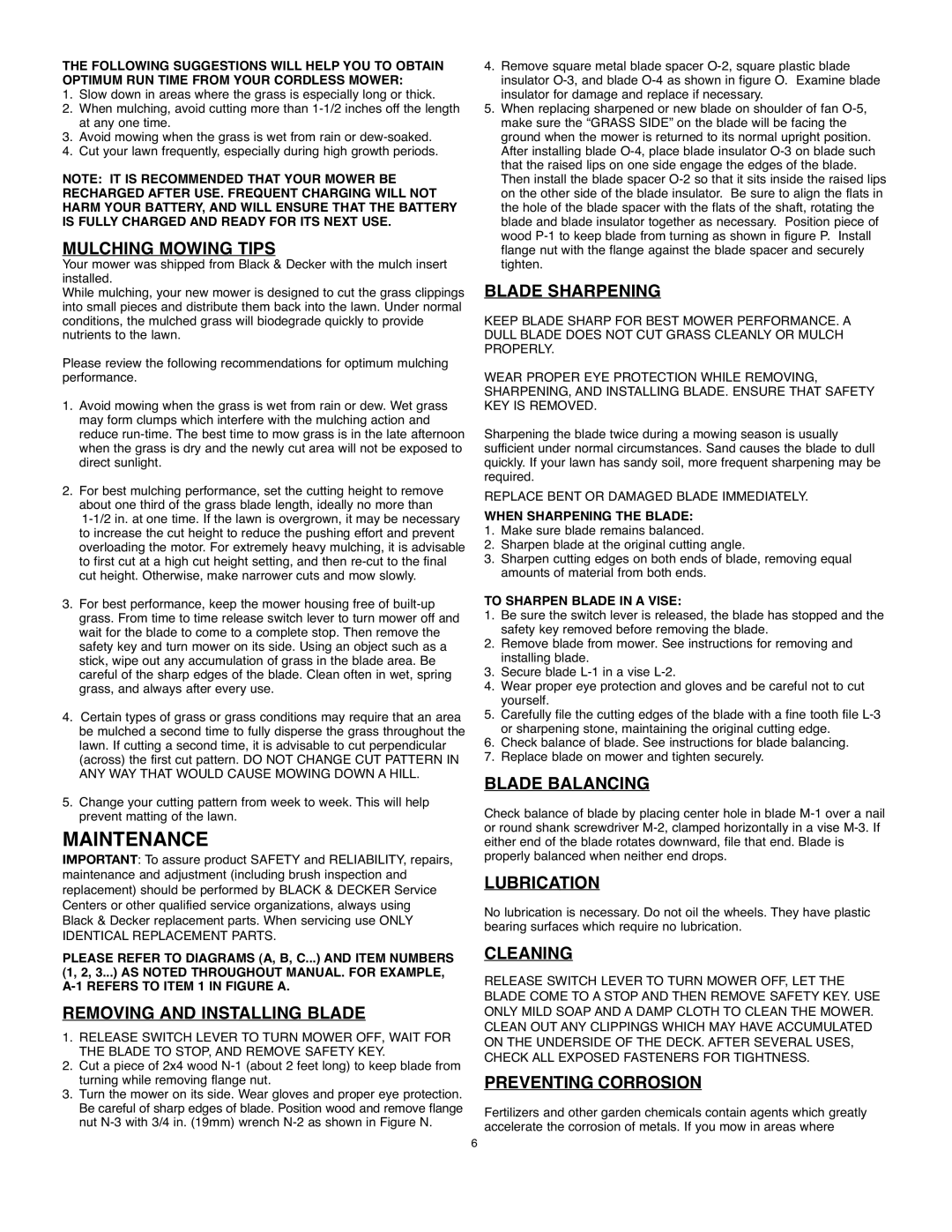THE FOLLOWING SUGGESTIONS WILL HELP YOU TO OBTAIN OPTIMUM RUN TIME FROM YOUR CORDLESS MOWER:
1.Slow down in areas where the grass is especially long or thick.
2.When mulching, avoid cutting more than
3.Avoid mowing when the grass is wet from rain or
4.Cut your lawn frequently, especially during high growth periods.
NOTE: IT IS RECOMMENDED THAT YOUR MOWER BE RECHARGED AFTER USE. FREQUENT CHARGING WILL NOT HARM YOUR BATTERY, AND WILL ENSURE THAT THE BATTERY IS FULLY CHARGED AND READY FOR ITS NEXT USE.
MULCHING MOWING TIPS
Your mower was shipped from Black & Decker with the mulch insert installed.
While mulching, your new mower is designed to cut the grass clippings into small pieces and distribute them back into the lawn. Under normal conditions, the mulched grass will biodegrade quickly to provide nutrients to the lawn.
Please review the following recommendations for optimum mulching performance.
1.Avoid mowing when the grass is wet from rain or dew. Wet grass may form clumps which interfere with the mulching action and reduce
2.For best mulching performance, set the cutting height to remove about one third of the grass blade length, ideally no more than
3.For best performance, keep the mower housing free of
4.Certain types of grass or grass conditions may require that an area be mulched a second time to fully disperse the grass throughout the lawn. If cutting a second time, it is advisable to cut perpendicular (across) the first cut pattern. DO NOT CHANGE CUT PATTERN IN ANY WAY THAT WOULD CAUSE MOWING DOWN A HILL.
5.Change your cutting pattern from week to week. This will help prevent matting of the lawn.
MAINTENANCE
IMPORTANT: To assure product SAFETY and RELIABILITY, repairs, maintenance and adjustment (including brush inspection and replacement) should be performed by BLACK & DECKER Service Centers or other qualified service organizations, always using Black & Decker replacement parts. When servicing use ONLY IDENTICAL REPLACEMENT PARTS.
PLEASE REFER TO DIAGRAMS (A, B, C...) AND ITEM NUMBERS (1, 2, 3...) AS NOTED THROUGHOUT MANUAL. FOR EXAMPLE,
REMOVING AND INSTALLING BLADE
1.RELEASE SWITCH LEVER TO TURN MOWER OFF, WAIT FOR THE BLADE TO STOP, AND REMOVE SAFETY KEY.
2.Cut a piece of 2x4 wood
3.Turn the mower on its side. Wear gloves and proper eye protection. Be careful of sharp edges of blade. Position wood and remove flange nut
4.Remove square metal blade spacer
5.When replacing sharpened or new blade on shoulder of fan
BLADE SHARPENING
KEEP BLADE SHARP FOR BEST MOWER PERFORMANCE. A DULL BLADE DOES NOT CUT GRASS CLEANLY OR MULCH PROPERLY.
WEAR PROPER EYE PROTECTION WHILE REMOVING, SHARPENING, AND INSTALLING BLADE. ENSURE THAT SAFETY KEY IS REMOVED.
Sharpening the blade twice during a mowing season is usually sufficient under normal circumstances. Sand causes the blade to dull quickly. If your lawn has sandy soil, more frequent sharpening may be required.
REPLACE BENT OR DAMAGED BLADE IMMEDIATELY.
WHEN SHARPENING THE BLADE:
1.Make sure blade remains balanced.
2.Sharpen blade at the original cutting angle.
3.Sharpen cutting edges on both ends of blade, removing equal amounts of material from both ends.
TO SHARPEN BLADE IN A VISE:
1.Be sure the switch lever is released, the blade has stopped and the safety key removed before removing the blade.
2.Remove blade from mower. See instructions for removing and installing blade.
3.Secure blade
4.Wear proper eye protection and gloves and be careful not to cut yourself.
5.Carefully file the cutting edges of the blade with a fine tooth file
6.Check balance of blade. See instructions for blade balancing.
7.Replace blade on mower and tighten securely.
BLADE BALANCING
Check balance of blade by placing center hole in blade
LUBRICATION
No lubrication is necessary. Do not oil the wheels. They have plastic bearing surfaces which require no lubrication.
CLEANING
RELEASE SWITCH LEVER TO TURN MOWER OFF, LET THE BLADE COME TO A STOP AND THEN REMOVE SAFETY KEY. USE ONLY MILD SOAP AND A DAMP CLOTH TO CLEAN THE MOWER. CLEAN OUT ANY CLIPPINGS WHICH MAY HAVE ACCUMULATED ON THE UNDERSIDE OF THE DECK. AFTER SEVERAL USES, CHECK ALL EXPOSED FASTENERS FOR TIGHTNESS.
PREVENTING CORROSION
Fertilizers and other garden chemicals contain agents which greatly accelerate the corrosion of metals. If you mow in areas where
6
